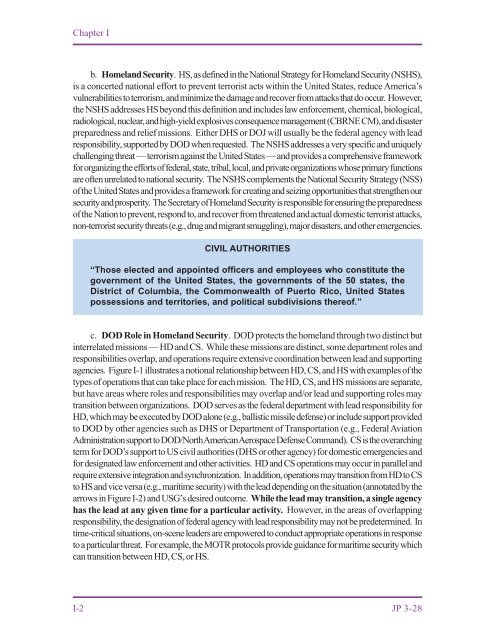JP 3-28, Civil Support - Federation of American Scientists
JP 3-28, Civil Support - Federation of American Scientists
JP 3-28, Civil Support - Federation of American Scientists
Create successful ePaper yourself
Turn your PDF publications into a flip-book with our unique Google optimized e-Paper software.
Chapter I<br />
b. Homeland Security. HS, as defined in the National Strategy for Homeland Security (NSHS),<br />
is a concerted national effort to prevent terrorist acts within the United States, reduce America’s<br />
vulnerabilities to terrorism, and minimize the damage and recover from attacks that do occur. However,<br />
the NSHS addresses HS beyond this definition and includes law enforcement, chemical, biological,<br />
radiological, nuclear, and high-yield explosives consequence management (CBRNE CM), and disaster<br />
preparedness and relief missions. Either DHS or DOJ will usually be the federal agency with lead<br />
responsibility, supported by DOD when requested. The NSHS addresses a very specific and uniquely<br />
challenging threat — terrorism against the United States — and provides a comprehensive framework<br />
for organizing the efforts <strong>of</strong> federal, state, tribal, local, and private organizations whose primary functions<br />
are <strong>of</strong>ten unrelated to national security. The NSHS complements the National Security Strategy (NSS)<br />
<strong>of</strong> the United States and provides a framework for creating and seizing opportunities that strengthen our<br />
security and prosperity. The Secretary <strong>of</strong> Homeland Security is responsible for ensuring the preparedness<br />
<strong>of</strong> the Nation to prevent, respond to, and recover from threatened and actual domestic terrorist attacks,<br />
non-terrorist security threats (e.g., drug and migrant smuggling), major disasters, and other emergencies.<br />
I-2<br />
CIVIL AUTHORITIES<br />
“Those elected and appointed <strong>of</strong>ficers and employees who constitute the<br />
government <strong>of</strong> the United States, the governments <strong>of</strong> the 50 states, the<br />
District <strong>of</strong> Columbia, the Commonwealth <strong>of</strong> Puerto Rico, United States<br />
possessions and territories, and political subdivisions there<strong>of</strong>.”<br />
c. DOD Role in Homeland Security. DOD protects the homeland through two distinct but<br />
interrelated missions — HD and CS. While these missions are distinct, some department roles and<br />
responsibilities overlap, and operations require extensive coordination between lead and supporting<br />
agencies. Figure I-1 illustrates a notional relationship between HD, CS, and HS with examples <strong>of</strong> the<br />
types <strong>of</strong> operations that can take place for each mission. The HD, CS, and HS missions are separate,<br />
but have areas where roles and responsibilities may overlap and/or lead and supporting roles may<br />
transition between organizations. DOD serves as the federal department with lead responsibility for<br />
HD, which may be executed by DOD alone (e.g., ballistic missile defense) or include support provided<br />
to DOD by other agencies such as DHS or Department <strong>of</strong> Transportation (e.g., Federal Aviation<br />
Administration support to DOD/North <strong>American</strong> Aerospace Defense Command). CS is the overarching<br />
term for DOD’s support to US civil authorities (DHS or other agency) for domestic emergencies and<br />
for designated law enforcement and other activities. HD and CS operations may occur in parallel and<br />
require extensive integration and synchronization. In addition, operations may transition from HD to CS<br />
to HS and vice versa (e.g., maritime security) with the lead depending on the situation (annotated by the<br />
arrows in Figure I-2) and USG’s desired outcome. While the lead may transition, a single agency<br />
has the lead at any given time for a particular activity. However, in the areas <strong>of</strong> overlapping<br />
responsibility, the designation <strong>of</strong> federal agency with lead responsibility may not be predetermined. In<br />
time-critical situations, on-scene leaders are empowered to conduct appropriate operations in response<br />
to a particular threat. For example, the MOTR protocols provide guidance for maritime security which<br />
can transition between HD, CS, or HS.<br />
<strong>JP</strong> 3-<strong>28</strong>

















